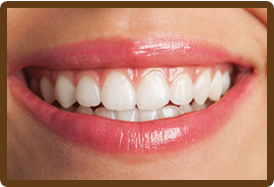PERIODONTICS
The term “periodontics” refers to the dental specialty that pertains to the prevention, diagnosis and treatment of periodontal disease that affects the gums and jawbone. The gum tissues serve to surround and support the teeth and the underlying jawbone anchors teeth firmly in place. Periodontists have completed several years of extra dental training and are concerned with maintaining the function, health and aesthetics of the jawbone and tissues.
Reasons for periodontal treatment
Periodontal disease is a progressive condition which begins with mild gum inflammation called gingivitis. It is the leading cause of tooth loss in adults living in the developed world, and should be taken very seriously. Periodontal disease (often called gum disease) is typically signified by red, swollen, painful, or bleeding gums, but in some cases has no noticeable symptoms.
Periodontal disease generally begins when the bacteria living in plaque cause an infection in the surrounding tissues of the teeth, causing them to become irritated and painful. Eventually, this infection will; cause the jawbone to recede and the tooth to become loose.
There are several reasons why periodontal treatment may be necessary:
- Moderate/advanced gum disease – This occurs when the gums are bleeding, swollen or red around most teeth and the jawbone has begun to recede.
- Localized gum recession – The infection which propagates moderate or advanced gum disease often begins in one area. Gum recession may also be caused due to over brushing with a hard bristle brush, or due to a tooth that is not positioned properly. Immediate treatment is required to prevent further spreading.
- Before crown lengthening – The periodontist may lengthen the crown of the tooth by removing surrounding soft tissue to provide more tooth exposure.
- Ridge augmentation – This procedure, often called “recontouring” may be required to correct an uneven gum line. Before embarking on treatment, a periodontist needs to treat any bacterial infections and periodontitis.
In the case of mild/moderate periodontal problems, the focus of the periodontist will be on curing the underlying bacterial infection and then providing advice on the most appropriate home cleaning methods.
Sometimes a deep scaling is needed to remove the bacterial plaque and calculus (tartar) from the teeth and tissues. Where periodontal disease is advanced and the jawbone has regressed significantly, more intensive cleaning may be recommended and loose teeth that cannot be saved will be removed.
The periodontist is trained in all aspects of dental implant procedures, which can restore functionality to the mouth when teeth have been affected by periodontitis.
Because periodontal disease is progressive, it is essential to remove the bacteria and calculus build up to halt the spread of the infection. Your dentist will be happy to advise you on effective cleaning methods and treatment options.
A periodontist is a dentist who specializes in the soft tissues of the mouth and the underlying jawbone which supports the teeth. A dentist must first graduate from an accredited dental school before undertaking an additional three years of study within a periodontology residency training program, in order to qualify as a periodontist.
The primary focus of this residency training is on both surgical and non surgical management of periodontal disease and the placement of dental implants.
Conditions Treated by a Periodontist
The periodontist is mainly concerned with preventing the onset of gum disease (periodontal disease), diagnosing conditions affecting the gums and jawbone, and treating gingivitis, periodontitis and bone loss. Periodontal disease is a progressive condition and the leading cause of tooth loss among adults in the developed world.
The periodontist is able to treat mild, moderate and advanced gum disease by first addressing the bacterial infection at the root of the problem, providing periodontal treatment, then providing information and education on good oral hygiene and the effective cleaning of the teeth.
The most common conditions treated by the periodontist are:
- Gingivitis – This is the mild inflammation of the gums which may or may not be signified by pain and bleeding.
- Mild/moderate periodontitis – When the pockets between the teeth and the soft tissues are measured to be between 4-6mm it is classified as moderate periodontitis (gum disease).
- Advanced periodontitis – When the pockets between the teeth and the soft tissues in general exceed 6mm in depth, significant bone loss may occur; causing shifting or loss of teeth.
- Missing teeth – When teeth are missing as a result of bone loss, the periodontist can implant prosthetic teeth. These teeth are anchored to the jawbone and restore functionality to the mouth.
Treatments Performed by a Periodontist
The periodontist is able to perform a wide range of treatments to halt the progression of gum disease, replace missing teeth and make the appearance of the smile more aesthetically pleasing.
Here are some of the treatments commonly performed by the periodontist:
- Implant placement – When a tooth or several teeth are missing, the periodontist is able to create a natural-looking replacement by anchoring a prosthetic tooth to the jawbone.
- Osteoplasty (hard tissue recontouring) – Once periodontitis has been treated, the periodontist can recontour the hard tissue to make the smile both natural-looking and aesthetically pleasing.
- Gingivoplasty (soft tissue recontouring) – As gums recede due to periodontitis, the teeth may appear longer; causing a “toothy” smile. The periodontist can remove tissues or straighten the gum line to make the teeth look more even.
- Bone grafting – Dental implants can only be positioned if there is sufficient bone to attach the prosthetic tooth to. If bone loss has occurred, bone grafting is an excellent way to add or “grow” bone so that an implant may be properly secured.
- Deep pocket cleanings – As gingivitis and periodontitis progress, it becomes more difficult to cleanse the pockets between the soft tissues and the teeth. The periodontist can scale and root plane the teeth (sometimes under local anesthetic) to remove debris and infection-causing bacteria.
- Crown lengthening – In order to expose more of the natural tooth, the periodontist can remove some of the surrounding gingival tissue.
The periodontist is a highly skilled dental health professional who is able to diagnose and treat many commonly occurring soft tissue and bone problems in the oral cavity.
Be sure to ask your periodontist if you have any questions or concerns.
Periodontal disease is the leading cause of bone loss in the oral cavity, though there are others such as ill-fitting dentures and facial trauma. The bone grafting procedure is an excellent way to replace lost bone tissue and encourage natural bone growth. Bone grafting is a versatile and predictable procedure which fulfills a wide variety of functions.
A bone graft may be required to create a stable base for dental implant placement, to halt the progression of gum disease or to make the smile appear more aesthetically pleasing.
There are several types of dental bone grafts. The following are the most common:
- Autogenous bone graft – In this type of graft the bone is removed from elsewhere in the body and implanted in the mouth. Common donor sites for bone grafting include the iliac section of the pelvis, the chin and the posterior third molar areas of the jaw. If large amounts of bone need to be harvested, the hip or the shin bone (tibia) is generally used.
- Allograft – Synthetic bone (man made) can be created in the laboratory and used in the bone grafting procedure. Bone can also be obtained from a bone bank (cadaver bone).
- Xenograft – This is the implantation of bovine (cow) bone. A xenograft is perfectly safe and has been used successfully for many years. Ample bone can be obtained and no secondary donor site is necessary.
Reasons for bone grafting
There are a wide variety of reasons why bone grafting may be the best option for restoring the jaw bone.
Dental implants – Implants are the preferred replacement method for missing teeth because they restore full functionality to the mouth; however, implants need to be firmly anchored to the jawbone to be effective. If the jawbone lacks the necessary quality or quantity of bone, bone grafting can strengthen and thicken the implant site.
Sinus lift – A sinus lift entails elevating the sinus membrane and grafting bone onto the sinus floor so that implants can be securely placed.
Ridge augmentation – Ridges in the bone can occur due to trauma, injury, birth defects or severe periodontal disease. The bone graft is used to fill in the ridge and make the jawbone a uniform shape.
Nerve repositioning – If the inferior alveolar nerve requires movement to allow for the placement of implants, a bone grafting procedure may be required. The inferior alveolar nerve allows feeling and sensation in the lower chin and lip.
What does bone grafting treatment involve?
Bone grafting is a fairly simple procedure which may be performed under local anesthetic; however if large amounts of bone area need to be grafted, general anesthetic may be required.
Initially, the grafting material needs to either be harvested or prepared for insertion. A small incision is made in the gum tissue and then gently separated from the bone. The bone grafting material is then placed at the affected site.
The bone regeneration process may be aided by:
- Gum/bone tissue regeneration – A thin barrier (membrane) is placed below the gum line over the grafting material. This barrier creates enough space for healthy tissue to grow and separates the faster growing gum tissue from the slower growing fibers. This means that bone cells can migrate to the protected area and grow naturally.
- Tissue stimulating proteins – Enamel matrix proteins occur during natural tooth development. Emdogain is a matrix protein product which is usually placed on the affected site before the gum is sutured. It mediates the formation of accellular cementum on the tooth which provides a foundation to allow periodontal attachment to occur. Tissue stimulating proteins help to create lost support in areas affected by periodontal defects.
- Platelet-rich growth factors –A high platelet concentration liquid can be used to create a blood clot at the site of a wound. It has recently been discovered that PRGF also stimulates bone growth – meaning a denser graft in a shorter time period.
The gum is sutured in place and a follow up appointment will need to be made within 10 days to assess progress. Bone grafting is a highly successful treatment and a good base for further periodontal restorations.
If you have any questions about bone grafting, please ask your dentist.
Bruxism refers to an oral parafunctional activity which occurs in most humans at some point in their lives. The grinding of the teeth and the clenching of the jaw are the two main characteristics of this condition, which can occur either during the day or at night.
Bruxism is one of the most common known sleep disorders and causes most of its damage during sleeping hours. The clenching and grinding which accompanies bruxism is symptomatic of a malfunctioning chewing reflex, which is turned off in non-sufferers when sleeping. For sufferers, deep sleep or even naps, cause the reflex nerve control center in the brain to turn off, and the reflex pathways to become active.
Typically, the incisors and canines (front 6 upper and lower teeth) of opposing arches grind against each other laterally. This side to side action puts undue strain on the medial pterygoid muscles and the temporomandibular joints. Earache, depression, headaches, eating disorders and anxiety are amongst the most common symptoms of bruxism; which often accompanies chronic stress, Alzheimer’s disease and alcohol abuse.
Bruxism is frequently misdiagnosed or not diagnosed at all, because it is only one of several potential causes of tooth wear. Only a trained professional can tell the difference between bruxing wear and wear caused by overly aggressive brushing, acidic soft drinks and abrasive foods.
A BiteStrip® is an economical device used to diagnose bruxism at home. The device itself is a small electromyography which senses and monitors any activity in the jaw muscles during sleep. The frequency and severity of the condition can then be assessed and the best treatment plan can be formulated.
Reasons for the treatment of bruxism
Here are some of the main reasons why bruxism should be promptly treated:
- Gum recession and tooth loss – Bruxism is one of the leading causes of gum recession and tooth loss; firstly because it damages the soft tissue directly, and secondly because it leads to loose teeth and deep pockets where bacteria can colonize and destroy the supporting bone.
- Occlusal trauma – The abnormal wear patterns on the occlusal (chewing) surfaces can lead to fractures in the teeth, which may require restorative treatment.
- Arthritis – In severe and chronic cases, bruxing can eventually lead to painful arthritis in the temporomandibular (TMJ) joints (the joints that allow the jaw to open smoothly).
- Myofascial pain – The grinding associated with bruxism can eventually shorten and blunt the teeth. This can lead to muscle pain in the myofascial region and debilitating headaches.
Treatment options for bruxism
There is no single cure for bruxism, though a variety of helpful devices and tools are available. Here are some common ways in which bruxism is treated:
- Mouthguards – An acrylic mouthguard can be designed from tooth impressions to minimize the abrasive action of tooth surfaces during normal sleep. Mouthguards should be worn on a long-term basis to help prevent tooth damage, damage to the temporomandibular joint and help to stabilize the occlusion.
- NTI-tss device – This device is fitted by a health professional and only covers the front teeth. The goal of the NTI-tss is to prevent the grinding of the rear molars by limiting the contraction of the temporalis muscle.
- Botox® – Botox® can be injected into the muscles to relax and weaken them. Botox® is an excellent treatment for bruxism because it weakens the muscles enough to prevent the grinding, but not enough to interfere with everyday functions like chewing and speaking.
Other methods of treatment include relaxation exercises, stress management education and biofeedback mechanisms. When the bruxing is under control, there are a variety of dental procedures such as crowns, gum grafts and crown lengthening that can restore a pleasant aesthetic appearance to the smile.
If you have questions or concerns about bruxism, please ask your dentist.
Crown lengthening is generally performed in order to improve the health of the gum tissue, or to prepare the mouth for restorative or cosmetic procedures. In addition, crown lengthening procedures can also be used to correct a “gummy” smile, where teeth are covered with excess gum tissue. Crown lengthening exposes more of the natural tooth by reshaping or recontouring bone and gum tissue. This treatment can be performed on a single tooth, many teeth or the entire gum line, to expose a pleasant, aesthetically pleasing smile.
Reasons for crown lengthening
Crown lengthening is a versatile and common procedure that has many effective uses and benefits. The vast majority of patients who have undergone this type of surgery are highly delighted with the results.
Here are some of the most common reasons for crown lengthening:
- Restoration of damaged teeth – Periodontal disease can cause severe damage to the teeth, as can trauma and decay. Where teeth have been broken beneath the gum line, crown lengthening can be used to prepare the area for a new restoration to correct the damaged teeth.
- Cosmetic uses – Extra gum tissue can make teeth look unnaturally short, and also increase susceptibility to periodontal infections. Removing excess gum tissue can restore a balanced, healthy look and thus improve the aesthetic appearance of the smile.
- Dental crowns – Crown lengthening serves to provide more space between the supporting jawbone and dental crown. This prevents the new crown from damaging gum tissues and bone once it is in place.
What does crown lengthening involve?
Crown lengthening is normally performed under local anesthetic. The amount of time this procedure takes will largely depend in how many teeth are involved and whether a small amount of bone needs to be removed, in addition to the soft tissue. Any existing dental crowns will be removed prior to the procedure, and replaced immediately afterwards.
The dentist will make a series of small incisions around the soft tissue in order to separate the gums away from the teeth. Even if only one tooth requires the re-contour, neighboring teeth are usually treated to provide a more even reshaping. Separating the gums provides the dentist with access to the roots of the teeth and the underlying bone.
In some cases, the removal of a small amount of tissue will provide enough tooth exposure to place a crown. In other cases, the dentist will also need to remove a small amount of bone from around the teeth. The bone is usually removed using a combination of special hand instruments, and rotary instruments. The rotary instruments roughly resemble the drill that is used in cavity treatment.
When the dentist is satisfied the teeth have sufficient exposure, the wound will be cleaned with sterile water and the gum tissue will be sutured with small stitches. The teeth will look noticeably longer immediately after surgery because the gums have now been repositioned.
The dentist will secure the surgical site using an intraoral (periodontal) bandage, which serves to prevent infection. Prescriptions may be provided for pain medication, and a chlorhexidine (antimicrobial) mouth rinse may be given to help reduce any bacteria attempting to re-colonize. The surgical site will be completely healed in approximately two to three months.
If you have any questions about crown lengthening, please ask your dentist.
A gum graft (also known as a gingival graft or periodontal plastic surgery), is a collective name for surgical periodontal procedures that aim to cover an exposed tooth root surface with grafted oral tissue.
Exposed tooth roots are usually the result of gingival recession due to periodontal disease. There are other common causes, including overly aggressive brushing and trauma.
Here are some of the most common types of gum grafting:
- Free gingival graft – This procedure is often used to thicken gum tissue. A layer of tissue is removed from the palate and relocated to the area affected by gum recession. Both sites will quickly heal without permanent damage.
- Subepithelial connective tissue graft – This procedure is commonly used to cover exposed roots. Tissue is removed fairly painlessly from the outer layer of the palate and relocated to the site of gum recession.
- Acellular dermal matrix allograft – This procedure uses medically processed, donated human tissue as a tissue source for the graft. The advantage of this is procedure is that there is no need for a donor site from the patient’s palate (and thus, less pain).
Reasons for gum grafting
Gum grafting is a common periodontal procedure. Though the name might sound frightening, the procedure is commonly performed with excellent results.
Here are some of the major benefits associated with gum grafting:
- Reduced sensitivity – When the tooth root becomes exposed, eating or drinking hot or cold foods can cause extreme sensitivity to the teeth. Gum grafting surgery permanently covers the exposed root, helps reduce discomfort, and restores the good health of the gums.
- Improved appearance – Periodontal disease is characterized by gum recession and inflammation. Gum recession and root exposure can make the teeth look longer than normal and the smile to appear “toothy.” Gum grafting can make the teeth look shorter, more symmetrical and generally more pleasing to look at. In addition, adjacent tissue can be enhanced and augmented during the procedure for aesthetic purposes.
- Improved gum health – Periodontal disease can progress and destroy gum tissue very rapidly. If left untreated, a large amount of gum tissue can be lost in a short period of time. Gum grafting can help halt tissue and bone loss; preventing further problems and protecting exposed roots from further decay.
What does gum grafting treatment involve?
Once the need for gum grafting surgery has been determined, there are several treatments the dentist will want perform before gum grafting takes place. First, the teeth must be thoroughly cleaned supra and subgingivally to remove calculus (tartar) and bacteria. The dentist can also provide literature, advice and educational tools to increase the effectiveness of homecare and help reduce the susceptibility of periodontal disease in the future.
The gum grafting procedure is usually performed under local anesthetic. The exact procedure will depend much on whether tissue is coming from the patient’s palate or a tissue bank.
Initially, small incisions will be made at the recipient site to create a small pocket to accommodate the graft. Then a split thickness incision is made and the connective tissue graft is inserted into the space between the two sections of tissue. The graft is usually slightly larger than the recession area, so some excess will be apparent.
Sutures are often placed to further stabilize the graft and to prevent any shifting from the designated site. Surgical material is used to protect the surgical area during the first week of healing. Uniformity and healing of the gums will be achieved in approximately six weeks.
If you have any questions about gum grafting, please ask your dentist.
The objective of scaling & root planning is to remove etiologic agents which cause inflammation to the gingival (gum) tissue and surrounding bone. Common etiologic agents removed by this conventional periodontal therapy include dental plaque and tartar (calculus).
These non-surgical procedures which completely cleanse the periodontium, work very effectively for individuals suffering from gingivitis (mild gum inflammation) and moderate/severe periodontal disease.
Reasons for scaling and root planing
Scaling and root planning can be used both as a preventative measure and as a stand-alone treatment. These procedures are performed as a preventative measure for a periodontitis sufferer.
Here are some reasons why these dental procedures may be necessary:
- Disease prevention – The oral bacteria which cause periodontal infections can travel via the bloodstream to other parts of the body. Research has shown that lung infections and heart disease have been linked to periodontal bacteria. Scaling and root planing remove bacteria and halts periodontal disease from progressing, thus preventing the bacteria from traveling to other parts of the body.
- Tooth protection – When gum pockets exceed 3mm in depth, there is a greater risk of periodontal disease. As pockets deepen, they tend to house more colonies of dangerous bacteria. Eventually, a chronic inflammatory response by the body begins to destroy gingival and bone tissue which may lead to tooth loss. Periodontal disease is the number one cause of tooth loss in the developed world.
- Aesthetic effects – Scaling and root planing help remove tartar and plaque from the teeth and below the gumline. As an added bonus, if superficial stains are present on the teeth, they will be removed in the process of the scaling and root planning procedure.
- Better breath – One of the most common signs of periodontal disease is halitosis (bad breath). Food particles and bacteria can cause a persistent bad odor in the oral cavity which is alleviated with cleaning procedures such as scaling and root planing.
What do scaling and root planing treatments involve?
Scaling and root planing treatments are only performed after a thorough examination of the mouth. The dentist will take X-rays, conduct visual examinations and make a diagnosis before recommending or beginning these procedures.
Depending on the current condition of the gums, the amount of calculus (tartar) present, the depth of the pockets and the progression of the periodontitis, local anesthetic may be used.
Scaling – This procedure is usually performed with special dental instruments and may include an ultrasonic scaling tool. The scaling tool removes calculus and plaque from the surface of the crown and root surfaces. In many cases, the scaling tool includes an irrigation process that can also be used to deliver an antimicrobial agent below the gums that can help reduce oral bacteria.
Root Planing – This procedure is a specific treatment which serves to remove cementum and surface dentin that is embedded with unwanted microorganisms, toxins and tartar. The root of the tooth is literally smoothed in order to promote good healing. Having clean, smooth root surfaces helps bacteria from easily colonizing in future.
Following these deep cleaning procedures, the gum pockets may be treated with antibiotics. This will soothe irritation and help the gum tissues to heal quickly.
During the next appointment, the dentist or hygienist will thoroughly examine the gums again to see how well the pockets have healed. If the gum pockets still measure more than 3mm in depth, additional and more intensive treatments may be recommended.
If you have any concerns or questions about scaling and root planing, or periodontal disease, please ask your dentist.
Pocket reduction surgery (also known as gingivectomy, osseous surgery and flap surgery) is a collective term for a series of several different surgeries aimed at gaining access to the roots of the teeth in order to remove bacteria and tartar (calculus).
The human mouth contains dozens of different bacteria at any given time. The bacteria found in plaque (the sticky substance on teeth) produce acids that lead to demineralization of the tooth surface, and ultimately contribute to periodontal disease.
Periodontal infections cause a chronic inflammatory response in the body that literally destroys bone and gum tissues once they invade the subgingival area (below the gum line). Gum pockets form and deepen between the gums and teeth as the tissue continues to be destroyed.
Periodontal disease is a progressive condition which, if left untreated, causes massive bacteria colonization in gum pockets can eventually lead to teeth falling out. Pocket reduction surgery is an attempt to alleviate this destructive cycle, and reduce the depth of the bacteria-harboring pockets.
Reasons for the pocket reduction surgery
Pocket reduction surgery is a common periodontal procedure which has been proven effective at eliminating bacteria, reducing inflammation and saving teeth. The goals of pocket reduction surgery are:
- Reducing bacterial spread – Oral bacteria has been connected to many other serious conditions such as diabetes, heart disease and stroke. Oral bacteria can travel to various parts of the body from inside the bloodstream and begin to colonize. It is important to decrease bacteria in the mouth in order to reduce the risk of secondary infection.
- Halting bone loss – The chronic inflammatory response induced by oral bacteria leads the body to destroy bone tissue. As the jawbone becomes affected by periodontal disease, the teeth lose their rigid anchor. When the teeth become too loose, they may require extraction.
- Facilitate home care – As the gum pockets become progressively deeper, they become incredibly difficult to clean by the patient. The toothbrush and dental floss cannot reach to the bottom of the pockets, increasing the risk of further periodontal infections.
- Enhancing the smile – An oral cavity that is affected by periodontal disease is not attractive to the eye. In fact, smiles may be marred by brown gums, rotting teeth and ridge indentations. Pocket reduction surgery halts the progression of gum disease and improves the aesthetics of the smile.
What does pocket reduction surgery involve?
Before recommending treatment or performing any procedure, the dentist will perform thorough visual and x-ray examinations in order to assess the condition of the teeth, gums and underlying bone. Pocket reduction surgery may be performed under local or general anesthetic depending on the preferences of the patient.
The gums will be gently pulled back from the teeth and bacteria and calculus (tartar) will be eliminated. Scaling and root planing will generally be required to fully remove the ossification (tartar) from the surface of the tooth root. If the root is not completely smooth, a planing procedure will be performed to ensure that when the gums do heal, they will not reattach to rough or uneven surfaces.
The final part of the surgery is usually the administration of an antimicrobial liquid to eliminate any remaining bacteria and promote healing. The gum is then sutured with tiny stitches that are left in place for 5-10 days.
Though the gums will be more sensitive immediately following the procedure, there will be a significant reduction in pocket depth and a vast improvement in the condition of the teeth and gums.
If you have any questions about pocket reduction surgery or treatment for periodontal disease, please ask your dentist.
Ridge modification is an effective procedure for treating deformities in the upper and lower jaws. These deformities can occur as a result of periodontal disease, trauma, injury, wearing dentures, or developmental problems. Such defects can leave insufficient bone for the placement of dental implants and an additional unattractive indentation in the jaw line adjacent to the missing teeth.
During the ridge modification procedure, the gum is lifted away from the ridge to fully expose the defect in the bone. The bony defect can be filled with bone graft material which can help regenerate lost bone, or a bone substitute. Finally, the incision is closed and several months of healing will be required. Depending on the case and type of implant and procedure, a dental implant may be placed during the ridge modification procedure or when healing is complete; much depends on the precise condition of the bone. Ridge modification improves the cosmetic appearance, functionality of the mouth, and the chance of enjoying dental implants for many years.















